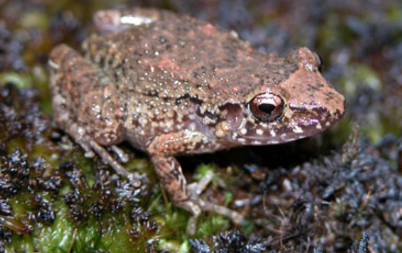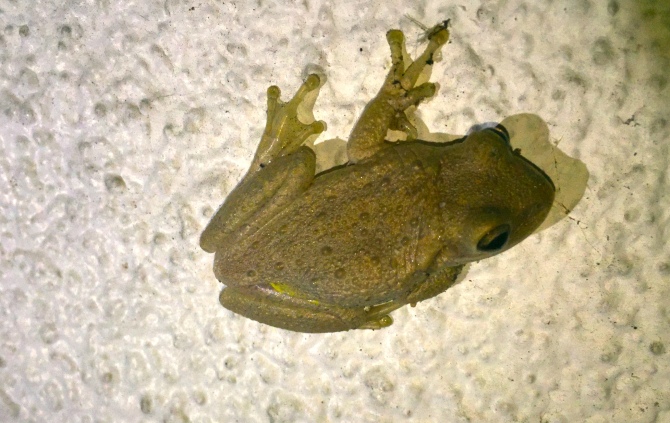GREEN HOUSE FROG

The greenhouse frog is a very small species, ranging from 17 to 31 mm (0.67 to 1.22 in) in length. These frogs are usually drab or olive-brown in colour, and occur in two forms; one has two broad stripes running longitudinally down the back, and the other is mottled. The undersides of both are a paler colour than the back, and the eyes are red.
The greenhouse frog is native to Cuba and some other islands in the West Indies. It has been introduced to Hawaii and Florida, where it has become common. It has been sporadically found in southern Georgia, southern Alabama and eastern Louisiana. It is an introduced species in Jamaica and Guam.It lives in moist leaf litter, often near human habitations, but is seldom seen because it is nocturnal. It sometimes emerges on warm, rainy days in summer, and in Florida, it has been found hibernating in March under the flaking bark of a wild tamarind (Lysiloma) tree.The diet of the greenhouse frog consists of small invertebrates, such as ants, beetles, mites, spiders, and roaches.
The greenhouse frog is unusual in that its eggs are not laid in water or in a frothy mass as is the case in some tree frogs. Instead, the eggs are enclosed in a thick membrane and laid singly in concealed, damp locations, such as beneath a log, buried in debris, or even under a flower pot. Clutch sizes vary between three and 26 eggs in Florida. They pass through their tadpole stage while still in the egg, and emerge as fully developed juvenile frogs about 5 mm (0.20 in) long with a short tail that soon gets reabsorbed. In warm conditions, hatching may occur on the 13th day of development. The tadpoles have an “egg tooth” on the end of their snouts to help them to emerge from the egg case. Afterwards, this is no longer of use, so is shed. The adult frog may provide some parental care by guarding the eggs, as frogs have been observed lurking in the vicinity of egg clumps.
CUBAN TREE FROG

The Cuban tree frog ranges in size from 3 to 5.5 in (76 to 140 mm) in length. It is the largest tree frog in North America. It has a rough, warty skin. Its toepads are much larger than those of other tree frogs, and it often has an orange tint to its eyes. It varies in color from olive-brown or bronze to gray or grayish-white.
Cuban tree frogs can change colors depending on their temperature and environment. Many individuals have darker splotches on the back, and some splotchy banding on the legs. In many individuals, the hidden surfaces of their legs are bright yellow. When the frog leaps to avoid a predator, these bright-yellow patches are visible, and may help to confuse the predator. Also, the skin on their heads is fused to the skull; if the head of an adult frog is rubbed (between the eyes), the skin does not move. This special adaptation prevents water loss, since fewer blood vessels occur in the “co-ossified” (fused) area. When handled, Cuban tree frogs secrete a toxic mucus from their skin. In humans, this can cause an allergic reaction or burning sensation to the eyes and nose, and even trigger asthma.